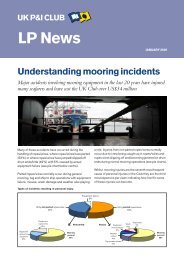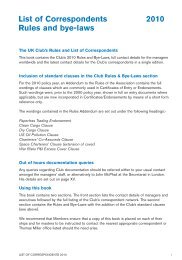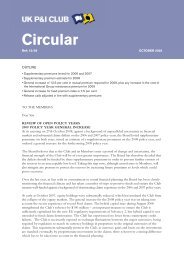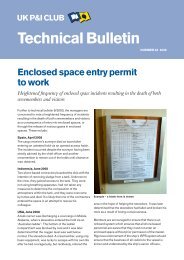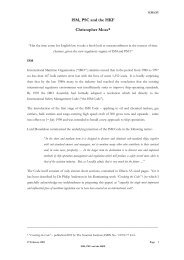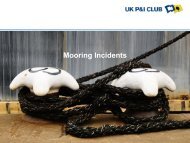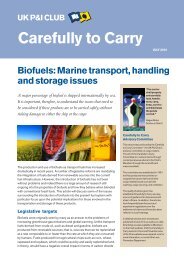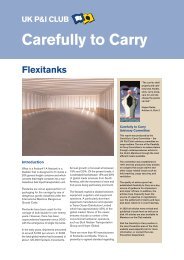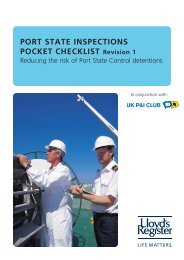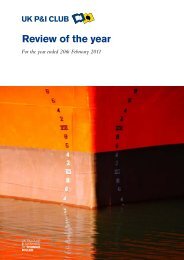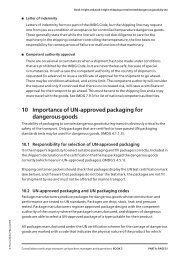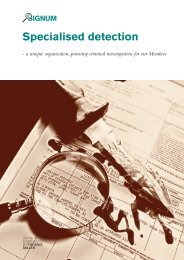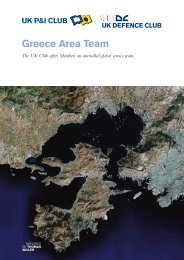ECDIS part 2 - UK P&I
ECDIS part 2 - UK P&I
ECDIS part 2 - UK P&I
You also want an ePaper? Increase the reach of your titles
YUMPU automatically turns print PDFs into web optimized ePapers that Google loves.
Photo CSMART<br />
(IMO) as an area of increased concern prompting a<br />
revision of the training requirements at the STCW 95<br />
conference held in Manila on 21 June 2010.<br />
Under the revised STCW 95 training requirements<br />
entering into force on 1 January 2012 under the tacit<br />
acceptance procedure, the Master and those in charge<br />
of a navigational watch are required to complete a<br />
generic <strong>ECDIS</strong> training course which meets the new<br />
standards laid down under the Manila amendments.<br />
This requirement pertains to all vessels fitted with<br />
<strong>ECDIS</strong> equipment irrespective of the fact that the<br />
primary form of navigation identified under the<br />
provisions of the company management system may be<br />
paper.<br />
In the <strong>UK</strong> the present situation has recently been<br />
clarified to some extent by Marine Information Notice<br />
(MIN) 405 entitled “Training for <strong>ECDIS</strong> as Primary<br />
Means of Navigation” which was published January<br />
2011.The notice clarifies what training is acceptable for<br />
masters and deck officers of <strong>UK</strong>-flagged vessels which<br />
have <strong>ECDIS</strong> as their primary means of navigation.<br />
MIN 405 presently does not however make any<br />
reference to training requirements for vessels fitted with<br />
<strong>ECDIS</strong> systems identified under the company<br />
operating procedures to be used as an ‘aid to<br />
navigation only’ with paper charts still identified as the<br />
primary means of navigation. As MIN 405 expires on 31<br />
December 2011 it is assumed that a further instruction<br />
will be issued reflecting the Manila amendments prior to<br />
the 1 January 2012.<br />
Type specific training<br />
In general terms the requirement for type specific<br />
training for <strong>ECDIS</strong> has been identified under Section 6<br />
of the ISM Code which establishes a clear requirement<br />
for not only effective training but familiarisation with<br />
respect to safety and emergency related duties.<br />
In addition to the ISM Code requirements, Marine<br />
Information Notice (MIN) 405 paragraph 3 now identifies<br />
a clear requirement for ship specific <strong>ECDIS</strong> training<br />
relating to the make and model of the equipment fitted on<br />
the ship on which the master or navigation officer is<br />
expected to operate. Marine Information Notice 405<br />
further clarifies that this training should build on the MCA<br />
approved generic training format and be delivered by the<br />
manufacturer; the manufacturer’s approved agent or a<br />
trainer who has attended such a programme.<br />
The present requirement relating to type specific training<br />
for <strong>UK</strong>-flagged vessel is now <strong>part</strong>ially clarified under the<br />
provisions of MIN 405. The use of the words ‘and be<br />
delivered’ does however suggest that the present<br />
solution adopted by many leading manufacturers<br />
providing computer based training programs may not on<br />
their own merits be considered suitable under the new<br />
guidelines.<br />
With the dilemma relating to type specific training now<br />
clearly identified, many shipping operators may be<br />
faced with the logistical headache of either training all<br />
their operational staff in every <strong>ECDIS</strong> system within the<br />
fleet or be required to provide an onboard certified<br />
‘trainer’ having previously completed a suitable ‘train the<br />
trainer’ course.<br />
With many shipping operators encountering difficulties<br />
finding a solution to their type specific training<br />
requirements two alternatives have been identified<br />
below;<br />
At the centre for training excellence at CSMART<br />
Almeria, Amsterdam (www.csmartalmere.com)<br />
developed in conjunction with a market leading cruise<br />
ship operator, <strong>ECDIS</strong> equipment has been<br />
standardised throughout the fleet with the bridge layout<br />
replicated at the training centre. This standardisation<br />
effectively circumventing the additional requirement for<br />
type specific training as all the systems operated within<br />
the fleet is the same.<br />
This training has been further advanced by the<br />
introduction of a revolutionary bridge team management<br />
approach moving away from the traditional rank<br />
structure adopting a function based airline style<br />
‘navigator / co-navigator’ system which has been proven<br />
to effectively reduce the risk of navigational hazards.<br />
An alternative solution to the issue of the training<br />
requirements of a multi functional and diverse shipping<br />
organisation operating many different <strong>ECDIS</strong> systems of<br />
various generations has been developed by <strong>ECDIS</strong> Ltd<br />
Southampton (www.ecdis.org) .<br />
Focusing on the needs of the modern ship manager and<br />
their respective requirements, <strong>ECDIS</strong> Ltd has




